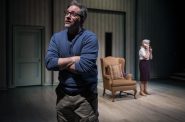Theatre Gigante’s The Lears explores growing old in America
“I couldn’t see dad this week.”
“Nursing homes depress me. I can’t stand the smell.”
“It’s difficult to be upbeat.”
Theatre Gigante’s The Lears is not the King Lear we all know.
Shakespeare dealt with universal themes that tempt producers to explore variations. Theaters change the staging, historical time period, format for presentation, even the language or the focus of the play. Isabelle Kralj and Mark Anderson of Theatre Gigante re-imagined King Lear as a performance piece that does all of that. The Lears premiered in UWM’s Studio 508 Theater at Kenilworth Square East Thursday night.
The Lears extracts parts of the original play, but centers on the theme of aging in America and abandonment of the elderly to institutional settings. Lear’s relationship with his three daughters remains basically intact. “Do they love me? How much? Which one loves me more?” Thus does Lear test them as he divides what he owns, as per Shakespeare. But The Lears could be about any modern family.
The clinical definition of dementia scrolls across a backdrop screen as the daughters decide whether to consign dad to the Fields of Dover independent living center. In a send-up of the rhetoric of such places, a radio ad extols the choices and active life style offered by the center, as the screen shows a close-up game of solitaire. Aides pantomime services that leave Lear feeling more helpless, even as he remains lucid enough to share his thoughts: “What’s it like to be retired? You’re free, but to do what?”
Some of the original subplots are incorporated as well. Edmund, a divorce lawyer here, causes and facilitates Regan’s freedom from her husband. Deaths abound as the play concludes. Most do not matter to us. One does. When Cordelia dies before she can rescue him, Lear has outlived all his daughters.
Kralj and Anderson added the framework of Greek tragedy to The Lears. Narrators and chorus carry the play. Actors deliver most of their lines while standing or sitting passively at microphones near the back of the stage. Jennifer Rupp – as Woman 2 (Lear’s daughter Regan) – showed that face, voice and attitude are enough to create a character. Regan lives, in all her saucy, bitchy, spoiled glory. The rest of the cast adhered more to the cool framework and restrained their effort. The Greek formality of the staging reduced the emotional effect.
Only John Kishline’s Lear moves freely throughout the play. Kishline is effective, though the setting grants him less opportunity for the theatrical posturing associated with this role. Rage and madness are in short supply, as Lear remains more lucid and reflective than usual.
Most of the language is contemporary, and often trivialized and vulgarized. Henny Youngman-style jokes and limericks break the flow. Bits of dialog from the original remind us of its beauty – or in the case of lines from Shakespeare’s Fool, of better-targeted humor. A saxophone and drums provide sound effects, background music, and songs from blues to Beatles. The pastiche limits the tragedy when tragedy could be the clearer vehicle for Kralj and Anderson’s advocacy argument, which sometimes conflates what is bad about growing old in America with what works.
Theatre Gigante’s The Lears doesn’t match the intensity of the original and fails to engage our emotions. But it does challenge us to think about contemporary issues, and it entertains us as it does.
In addition to Kralj and Anderson (as writers, producers and actors), the cast includes James Butchart, Leslie Fitzwater, John Kishline and Jennifer Rupp. Composer/performers Aaron Gardner and Seth Warren-Crow provide the music, with video/visuals by Iain Court and lights by Nathan Booth. Through Nov. 21 in the Studio 508 at the UWM Kenilworth East building, 1925 E. Kenilworth Place, at Prospect. More info here.
Theater
-
New Musical a Life and Death Comedy
![Stephanie Beschta [Mrs. McCobb] and Shayne Patrick [Mr. McCobb] in RIP – A Matter of Life and Death. Photo by Stacy Kaat (www.stacykaat.com).](https://urbanmilwaukee.com/wp-content/uploads/2024/07/WEB-6056-185x122.jpg) Jul 19th, 2024 by Dominique Paul Noth
Jul 19th, 2024 by Dominique Paul Noth
-
‘The Treasurer’ a Darkly Funny Family Play
 Apr 29th, 2024 by Dominique Paul Noth
Apr 29th, 2024 by Dominique Paul Noth
-
Rep’s Nina Simone Play a Puzzle
 Apr 23rd, 2024 by Dominique Paul Noth
Apr 23rd, 2024 by Dominique Paul Noth






















